More Odds & Ends: Core Set 2019
Last week, I started answering your questions about Core Set 2019. You asked a lot of good questions, so let's keep going.
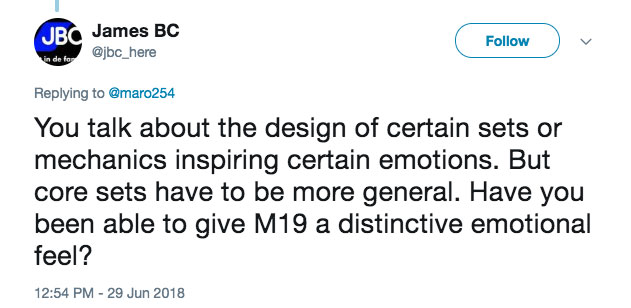
The job of most expansions is to create an identity for itself to help set it apart from all the sets around it. I believe this upcoming year will have Magic's one hundredth expansion, and we work hard to set each apart. We do this in many ways. We have a unique mechanical identity. We set each expansion usually on a singular world that we get to flesh out. And we tried to set a distinctive emotional tone to make playing this expansion feel different from other Magic expansions.
Core sets have a slightly different goal. It's about introducing the world of Magic to new players while serving as a palate cleanser for the enfranchised players. As such, we tend to tone down the mechanical contrast. The set is more or less about meat-and-potatoes Magic play. Rather than try to feel different from other expansions, it's trying to feel similar to other core sets. Creatively, it's more of a sampler. Rather than focus on a singular world, the core sets show off the variety of different worlds (and creatures and spells) the game has to offer.
Emotionally, we're trying to tap into the core of the Magic play experience, the joy of discovery. As such, the core set is not trying to set itself apart as much as it's trying to capture what every Magic set captures. I often talk about how R&D sees Magic as a pendulum (the swinging-bob-over-sand type), and we're constantly pushing it in new directions. The core sets are trying to be the pendulum when it's close to the center, when it represents the most universal Magic experience.
All of this is a long-winded way of saying that Core Set 2019 isn't trying to create some kind of new emotional feel, but rather capture the universal feel we all remember from when we first started playing.
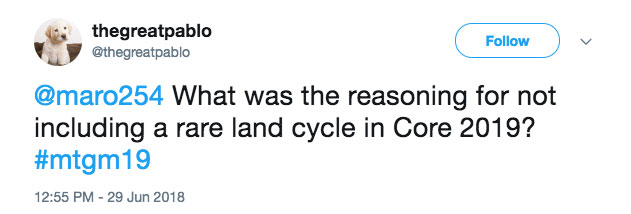
One of the biggest challenges of making Magic is that you have different concerns that often fight against one another. Here are two of them:
Sets like to have a rare dual land cycle because rare dual land cycles sell sets. They're universal and applicable to a lot of different decks. Also, players have learned over the years that dual lands are something they need, so new dual lands instantly get attention and, most of the time, are embraced quickly by the players, especially the more enfranchised players who tend to be the loudest voices on social media.
Standard can only have so many dual lands because if we create too many, it gets too easy to just play as many colors as you want. The color wheel exists for a reason, and making sure players must respect it in deck building is important for the health of the game.
Now, these two things come in conflict because there are eight sets in Standard, at its fullest, and Standard can't support eight cycles of dual lands outside of a specifically designed heavy multicolor environment. The answer is to find the occasional set from which to leave out a dual land cycle. That won't always be the core set, but it was last in line when they were handed out, and this time, it didn't get a cycle.
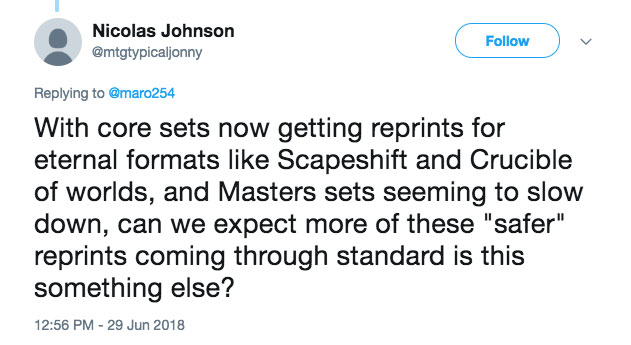
One of the reasons to bring back the core sets is its ability for us to bring back reprints that are harder to do in normal expansions. Core Set 2019 in particular is us being a lot more aggressive about trying to find reprints for older formats. Is this something we plan to do more of in future core sets? It depends a lot on the success of how the cards we reprinted in Core Set 2019 do. It's our hope that Core Set 2019 can be a blueprint moving forward of how to do this.
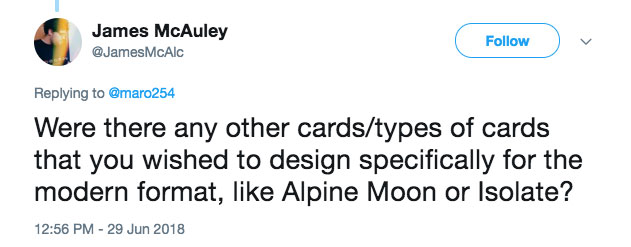
Once we decided to experiment with designing new cards for older formats in Core Set 2019, we designed a whole bunch of cards. We only had so many slots, so we picked the ones we thought had the best chance and printed those. If this experiment works, we have a lot of other designs waiting in the wings to try out.
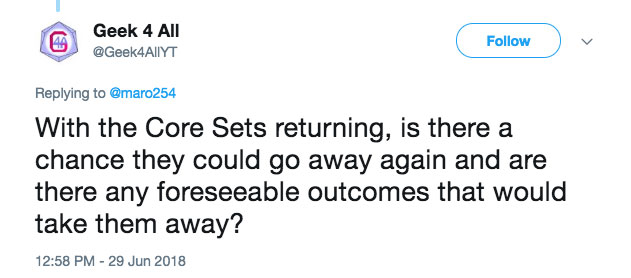
Usually when we make a decision and then reverse our decision, we're pretty cautious about making sure whether reversing it is the right thing to do, because the absolute last thing we want to do is reverse it yet again. The audience can understand us trying something and it not working out, but having it toggle back and forth too many times causes the audience to lose confidence in us.
I can say that by all metrics we're observing, Core Set 2019 seems to be doing a good job of what it was created to do. Core Set 2020 is well into design, and it's our intent to continue doing the core set as a regular ongoing thing. So, is there a chance we'll stop doing the core sets again? Yes, there's a chance, as we're willing to change course if we have enough evidence that we've made a grave mistake. But in general, I'm pretty confident core sets are here to stay.
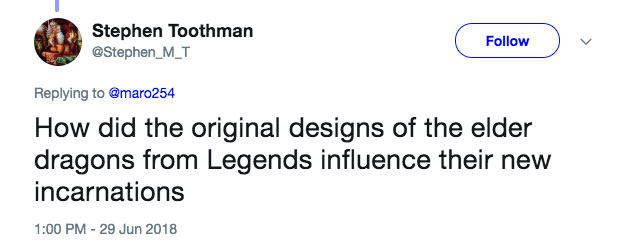
I think the Elder Dragons' designs were more influenced by their flavor than their previous card designs, but a little mechanical influence definitely snuck through.
Because Arcades's colors lend themselves more toward a defensive deck, both cards tend to focus on toughness. The Legends card grants it, while the Core Set 2019 card takes advantage of creatures having higher toughnesses.
Chromium, the Mutable has no real mechanical overlap other than it keeps the 7/7 stats from the original Legends version. The Core Set 2019 version is playing more into a flavorful story point about Chromium being able to change shape.
The front side of the Core Set 2019 version of Bolas makes a nod to the discard ability of the original Legends version and definitely captures the overall feeling of brutality that made the original card popular.
The Legends version of Palladia-Mors was just a big bruiser, and the Core Set 2019 version carries that over by including both flying and trample. The Core Set 2019 version then improves upon it by adding two other abilities: vigilance and limited hexproof.
Like Chromium, Vaevictis Asmadi, the Dire makes a diversion from its Legends card that tries to colorfully tie into the character. The goal on both these cards was to make them a little more interesting to play than just being a large flying attacker.
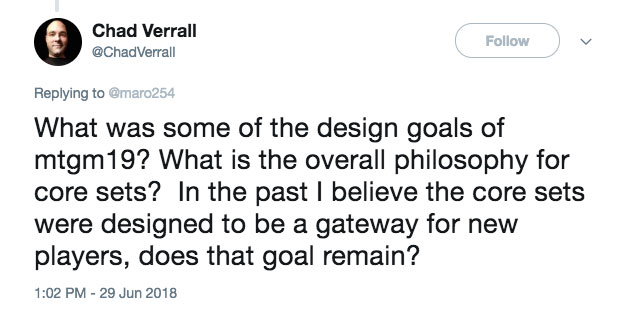
When we returned to core sets, we decided to double down on them as entry points for new players. We designed them along with the entire entry-level pipeline to make sure that the core set was maximizing making those products the best that they can be (and feedback we've gotten from stores is that we succeeded). We chose to move away from some previous choices (such as adding in a non-evergreen keyword) that made enfranchised players happy at the cost of adding complexity for the new players. (We offset this, by the way, by designing cards at higher rarities tuned to formats we know enfranchised players play more often.) If you'd like more on this topic, I wrote an entire article about it back in June.
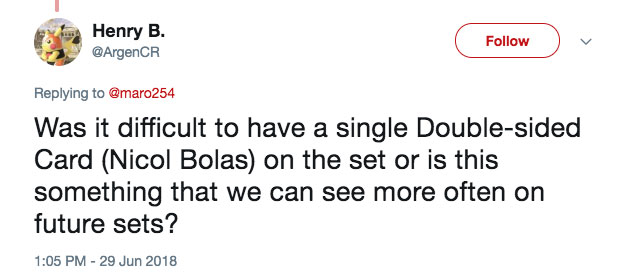
We've always had the ability to print a single-double sided card. It requires printing an extra double-sided sheet (most cards have normal Magic backs, which are preprinted en masse prior to sets being printed) of nothing but that card. Doing this has logistical and, more importantly, financial implications, meaning that it's something that has to be important enough to justify doing. Having Core Set 2019 built around Nicol Bolas and his past felt like it was central enough to the set to justify.
It's also important to note that Core Set 2019 didn't have any other element that required special printing resources. Every set has some budget to do things out of the norm, but there's only so much per set that can be done. Another set might have a great reason to have a single double-faced card, but if there are other factors required to make that set, the double-faced card might be squeezed out for those other things. Note that those things can include any factor that goes into printing, from the cards themselves and collation to packaging and various logistical concerns.
So, in short, it's something we can do again, but there are a lot of factors that go into being able to do it.
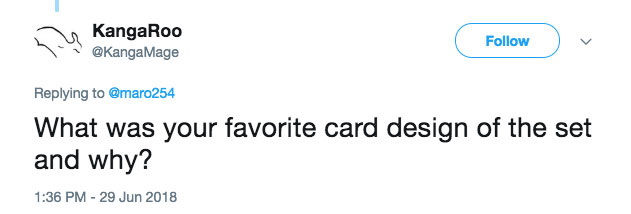
I think my favorite card is Desecrated Tomb.
Magic is celebrating its 25th birthday this year, and we've printed over 16,000 unique cards, so I'm always tickled when we find a cool build-around card that plays into a space we haven't already done before. Add to that some cool top-down flavor, and you get a card that's a really neat total package.
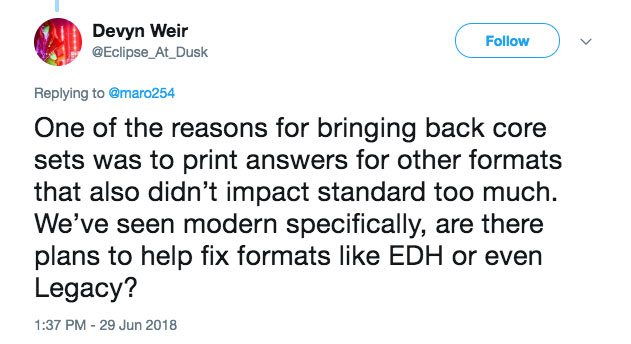
There are definitely some designs in the set with Commander in mind. I also believe a few of our Modern shots have the potential to see play in Legacy. Legacy-relevant cards in particular are hard to do when they first have to go through Standard. What we tend to have the best success with are cards that are strong but very narrow, so much so that there aren't enough cards in Standard to make a tournament version of the deck. The trick is making the cards feel like they have a purpose in newer formats, even if just casually.
I should note that Core Set 2019 is our first returning core set. We did a lot of experimenting in it, and as we see how those experiments turn out, it will fuel future experiments. I talked about how one of the reasons to bring back core sets was our ability to design things in a vacuum and get cards into environments that are hard to do in a normal expansion. I expect future core sets to continue to play in this space.

One of the interesting things about being behind the scenes is having a greater awareness of all the minutiae we have to care about. For example, I believe it's Arcades and not Arcades Sabboth because the latter simply doesn't fit on the card title bar. Both b and h are pretty fat letters. One of the tricks we can do is to use fewer mana symbols on cards with longer names, but there really wasn't a way to get away with fewer than four mana bubbles. Arcades has to be three colors based on his old card (and the fact that he's part of a three-color cycle), and he's too big, as a Dragon, to only cost three mana. Why don't we just shrink the font size? Because we want the cards to be legible and we need a little wiggle room for when cards are printed in other languages. "The Strategist," for instance, might be longer in a few of the eleven languages in which we print cards.
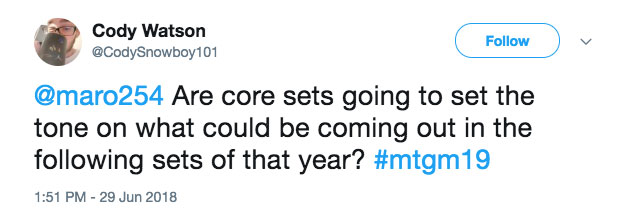
We're in the process of experimenting. Core Set 2019 played around with using story from the past to be relevant to the ongoing storyline. That doesn't mean every future core set will do the same. I expect us to use the first few as testing grounds to try out different ways we can use the core set to connect to the story and over time to start adopting some ongoing rules as we better understand what does and doesn't work.
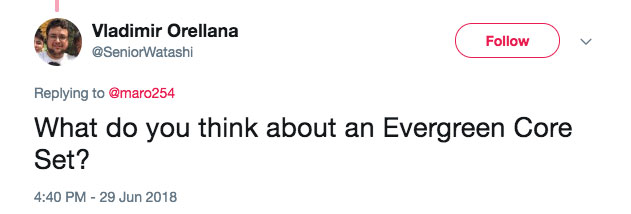
Back in the day, about fifteen or so years ago, we had this concept for what we called "UBS" (the Ultimate Base Set). The idea was that what we wanted wasn't an ever-changing core set but rather a single locked core set that would always serve as the entry point for the game. We actually spent a lot of time talking about what UBS wanted to be and what cards needed to go in it.
Eventually, we realized the error of our ways.
- Magic is a game about flux. Having the introductory product not tap into one of the core identities of the game felt wrong.
- Because the game is in flux, any decision we made for a locked set would eventually have to change. For example, we might assume a keyword is evergreen and thus include a card with it only to years later decide it shouldn't be evergreen anymore and have to remove it. Note that the game changes in many ways, not just mechanically but also in the creative.
- As I've talked about numerous times in this mailbag column, one of the reasons we brought back core sets was the flexibility it allowed us to add cards to Standard that would be difficult to put into an expansion. Locking it would cut off our ability to do this.
- While the core set is focused primarily on the beginner, we still want it to be enjoyed by enfranchised players. If the set never changed, they would make that task near impossible.
- We need to market the core set. Having new elements and new cards makes that possible.
So, on the surface, it seems like a cool idea, but when you dig deeper, you realize that an evergreen core set would create more problems than it would solve.
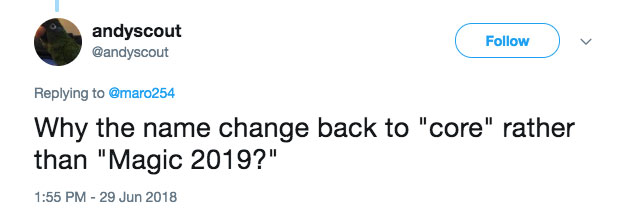
There are a number of reasons. Here are the three most important:
- Ease of vernacular – When I say I played the "Magic set," that doesn't exactly make it clear what I've played. By giving the product line a word to call its own, it allows players to be able to refer to it in a way that makes it clear what it is.
- Stopping duplication – Technically, the product is Magic: The Gathering Core Set 2019. If it was Magic 2019, that would make it Magic: The Gathering Magic 2019. Yes, that isn't a problem in the vernacular, but it does make it look clunky when we have to print out the official title.
- Product definition – The word "core" explains that this is a base product in a way that "Magic" doesn't. Having small clues that help push beginners in the right direction is important and is a huge aspect of what the name for the product is all about.
Tweet and Greet
That's all the time I've got for today, but I have a whole column left of questions to answer, so I'll be back with more answers next week. As always, if you have any comments on today's article or any of my answers, or even just on Core Set 2019 itself, please feel free to email me or contact me through social media (Twitter, Tumblr, Google+, and Instagram).
Join me next week for part three.
Until then, may you have as much fun playing Core Set 2019 as we had making it.
#559: Unstable Cards, Part 6
#559: Unstable Cards, Part 6
1:02:13
This podcast is part six of a six-part series on the design of each and every non-Contraption card in Unstable.
#560: Tuesday Magic Meeting
#560: Tuesday Magic Meeting
44:11
In this podcast, I talk all about a longstanding meeting we have every week in R&D.
- Episode 558 Unstable Cards, Part 5
- Episode 557 Unstable Cards, Part 4
- Episode 556 Video with Richard and Peter

